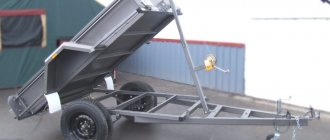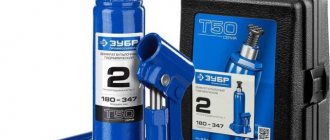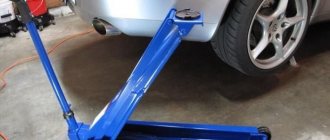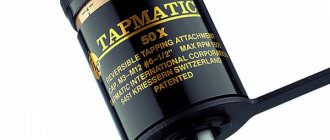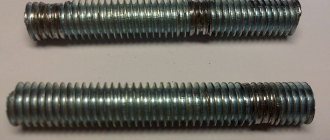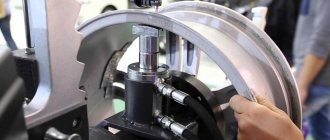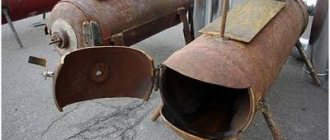Due to the lack of the required number of guarded parking lots, car owners install not only alarms on their cars, but also secret bolts on the wheels. Fastening elements with non-standard head shapes are called “secret”. They cannot be unscrewed with a balloon tool; fastening can only be done with the special tool that comes with the kit.
Design features of car wheel mounting bolts
Product parameters must correspond to the characteristics of a car wheel. The main parameters of bolts include:
- dimensions and direction of thread;
- turnkey size;
- strength class.
Cars
Nuts of types “A”, “B” and “C” are available with six types of small format threads. For M12 the thread pitch can be 1.25 mm, for M12, 14, 18, 20, 22 the thread pitch is 1.5 mm.
Freight
Class “D” nuts are intended for truck wheels. These are M18, 20, 22 hardware with a thread pitch of 1.5 millimeters. The thread direction can be right or left. The size of the wrenches for the nuts is 17, 19, 24, 27, 30 or 32.
Thread markings
If we talk about threads, there are two measurement systems: metric and inch. Example of metric marking: M14x1.5. “M” means “metric”, “142” is the outer diameter of the thread in millimeters, “1.5” is the pitch of one turn. An inch thread is designated, for example, as 1/5″x20, where “1/5” is the outer diameter of the thread, and “20” is the number of turns per inch of length.
You also need to consider the thread length of the bolt. If it is too long, then when tightening the bolt will rest against the hub. If it is too short, then the number of twisted turns may simply not be enough to securely fix the wheel.
This is especially true for those who have two sets of tires on two sets of wheels. For example, if the winter set is on stamped wheels, and the summer set is on cast wheels. For alloy wheels the bolts are usually longer.
For nuts this problem is not so pressing. But it may happen that when installing some types of disks, the length of the factory studs in the wheel hub is not enough. Then they will need to be replaced at a car service center.
It is important to note: bolts and nuts should be tightened with a torque wrench to the tightening torque recommended by the car manufacturer.
Classification of wheel bolts and nuts
Based on their applicability, fasteners are divided into several groups - according to the side of installation on the car and the possibility of operation with one or another type of wheel rims. Incorrectly installed fasteners can lead to deformation of the wheel part during vehicle operation. For example, a hardware rotary wheel with a bolt comes in a single set and is designed for bolts of 50-100 mm.
Appearance and service life
When choosing, most motorists tend to choose chrome-plated wheel bolts. However, no type of topcoat provides guaranteed protection against corrosion. It all depends on the operating conditions and quality of care. Molybdenum and nickel-plated screws are not inferior in performance.
The only objective advantage is the spectacular and aesthetic appearance of the chrome coating
The service life depends on the strength class, which is recognized as a quality mark. The higher this indicator, the longer the product can be used before corrosion occurs. The existing fittings are produced at Russian, European and Chinese factories. Russian-made mounts are suitable for domestic cars. For Volkswagen and other auto industry giants, you should choose Italian models created specifically for European cars. There are special catalogs for them with a number and article number.
Purchasing bolts for caps can sometimes be the only solution to the problem. For example, deficiencies in PCD readings between holes can be corrected using eccentrics. In addition to the main function, this part plays the role of an accessory that transforms the appearance of the car. To confidently move on the roads, you should determine what type of accessories will suit a particular vehicle.
Installing the wheel and tightening the bolts
If the wheel is attached with 4 bolts, you should attach any bolt, and then the next one on the opposite side of the center hole.
Work progress:
- The wheel is installed on studs and secured with bolts.
- The security bolts are lightly tightened using a wheel wrench.
- The car is jacked up and the supports are removed.
- The car is lowered to the ground and all the wheel bolts are tightened in a circle. It is recommended that every effort be made to ensure that the wheel is securely secured. There is no need to be afraid of stripping the thread.
During installation, you need to make sure that the wheel lock parameters match and are suitable in length and diameter. When servicing the machine, the lock is always installed last. And this element should always be dismantled first.
Wheel studs
So, wheel studs, and we’ll start with them, have 3 fundamental parameters:
- diameter and thread pitch,
- length,
- diameter of the driving part.
The last parameter is the most important, because it is with this part that the stud is pressed into the hub. It is necessary to select the driving part of the stud with an accuracy of hundredths. A discrepancy of 0.05 mm can lead to the fact that the stud will hold loosely in the hub and will turn during the next installation. Or, if the driving part is larger, it will not fit into the driving hole of the hub.
There is no point in talking about self-selection - the size of the stud depends solely on the make and model of the car. It is not uncommon for the studs on the rear and front axles to be different, either in the drive part or in length, even in the same car. Therefore, advice from our store is to order wheel studs in the original design or high-quality analogues in specialized stores, where they will help you with the selection. The second option is economically more profitable, but will be fully justified only if there is no doubt about the competence of the seller and the quality of the goods he sells.
The main thing about secret bolts
The purpose of the secret bolt is to protect the wheels from theft. The fastening unit has a head for a special key. Only the owner of the car will have the key to the bolts. Locks are popular among car enthusiasts, and many auto repair shops have similar or similar keys in stock, so it is recommended to select less common models.
Advantage and difference from conventional fastening bolts
The advantages and differences from traditional bolts are as follows:
- The bolt head is positioned low.
- The elements are protected by special rings.
- The wheel security bolts are made from high quality raw materials.
Varieties
Certain design differences should be taken into account when choosing secrets:
- The products have an outer head in the shape of an asterisk or polyhedron. The models are very popular among consumers.
- A bolt with an internally shaped head in the form of stars or special shapes. The downside of such secrets is their tendency to accumulate dirt.
- An element with one or more protective rings.
- Bolts that have heads of non-standard sizes. The shape of the pattern can be internal or external.
- Secret wheel bolts with several holes in the head. The design features are that the holes are not located according to a strictly established system, but correspond to certain dimensions of the fastener head. It will be difficult to adapt and unscrew this type of hardware in case of loss of the secret key.
What is important when choosing
When choosing, you need to decide on the following parameters:
- Dimensions. External characteristics are not decisive in selection. It is important to determine the diameter, length, depth and width of the well, and revolutions.
- Material. This is an equally important point when selecting fasteners. The main requirements in this case are aesthetic appearance and high strength. Budget products are made from metal, the rest are made from high-quality steel.
- Appearance. The ferrous metal rod negates the effect of the cast hubcaps. The modern Russian tuning market offers a wide range of decorative coatings. All that remains is to make a choice.
What to do if the wheel bolt does not come off
Some car enthusiasts do not know what to do if the fasteners do not move. The first step is to put the vehicle on the handbrake and make sure that the vehicle is stationary. A stuck bolt can be unscrewed in the following ways:
- Leverage method. Due to the insufficient length of the wheel wrench handle, it is not possible to turn the bolt with the required force. It's easy and safe to use a wrench handle extension or a long-handled tool. Such a device will increase the strength of the mechanical influence. Experienced motorists recommend using a metal pipe to lengthen the handle.
- Use your leg strength. If you cannot unscrew the bolt by hand, you need to try pressing the tool with your foot. The handle of the wrench should be parallel to the surface of the ground. You will need to press the key with your foot and turn it counterclockwise. In extreme cases, you will need to stand on the key with both feet and hold on to the car body with your hands.
- Use a hammer or mallet. You will need to pick up both tools, place the mallet in the right place and hit it with a hammer. This option will help move the threads of a frozen nut. In extreme cases, a hammer can replace a stone. Avoid glancing impacts that damage the bolt and key. The blows must be accurate.
- Using a wrench with a dynamometer. If the wheel fasteners have been secured too tightly, it is recommended to use a tool with a dynamometer. Recommended force parameters are indicated in the device instructions.
- Use of chemical compounds. If the bolts are too tight, Liquid Wrench or PB Blaster should be used. Apply the product to the bolt using a watering can with a thin spout. After waiting 10 minutes, dismantling begins.
Secrets
For car owners, the issue of protecting their car from theft or theft of parts has become no less pressing. Along with alarms and anti-theft devices, security bolts are popular. They have a special head for a key, which is included in the kit. Only the owner can open it. Vandals may try to forcefully remove the wheels, but nothing will work. It is no secret that in car services there are similar keys that are easy to pick up.
You might be interested in this: Wheel sizes for Nissan Almera G15
For maximum protection, it is advisable to choose the least common product
Types of secrets:
- With a curly profile. Lines of varying curvature are applied to the object. An intricate design is stamped onto the head, the imprint of which is repeated on the hollow key.
- With holes. Asymmetric holes of various sizes are drilled into the rod. The key, in turn, has correspondingly shaped protrusions. Options are possible when the convex parts are located on a metal rod, and the holes are on keys.
Note!
The downside is the likelihood of losing the key. In this case, neither the thief nor the owner himself will be able to remove the secrets. If there is a strong impact, there is a possibility of breaking the knob.
Types of fasteners
Here are the types of fasteners needed for alloy wheels:
- Bolts are metal rods with a screw thread at the end. Used to connect detachable elements.
- Nuts are round-shaped parts designed to fasten elements by screwing a metal die onto threaded rods.
Steel, aluminum or titanium alloys are used to produce products.
Titanium bolts are distinguished by high quality indicators. Black bolts for alloy wheels are made from steel with the addition of molybdenum or steel with a chrome or nickel coating.
Eccentrics
Standard fasteners have a hexagon shape, a threaded part and a conical clamping part. A unique characteristic of disc eccentric bolts is their floating cone with an offset center of gravity.
The degree of displacement can range up to 1 mm
The axial distance between holes may vary. The standards for this PCD indicator are varied and not always fully thought out. The result is vibration while driving. This makes it more likely that bearings, levers and rubber bands will fail faster. For such cases, the ideal solution would be to use eccentrics. Thanks to the movable cone, a gap is formed between the inner and outer diameters.

